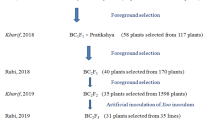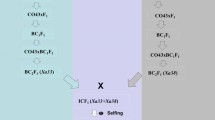Abstract
Bacterial blight (BB) of rice caused by Xanthomonas oryzae pv. oryzae (Xoo) is a major disease of rice in several countries. Three BB resistance genes, xa5, xa13 and Xa21, were pyramided into cv. PR106, which is widely grown in Punjab, India, using marker-assisted selection. Lines of PR106 with pyramided genes were evaluated after inoculation with 17 isolates of the pathogen from the Punjab and six races of Xoo from the Philippines. Genes in combinations were found to provide high levels of resistance to the predominant Xoo isolates from the Punjab and six races from the Philippines. Lines of PR106 with two and three BB resistance genes were also evaluated under natural conditions at 31 sites in commercial fields. The combination of genes provided a wider spectrum of resistance to the pathogen population prevalent in the region; Xa21 was the most effective, followed by xa5. Resistance gene xa13 was the least effective against Xoo. Only 1 of the BB isolates, PX04, was virulent on the line carrying Xa21 but avirulent on the lines having xa5 and xa13 genes in combination with Xa21.
Similar content being viewed by others
Author information
Authors and Affiliations
Additional information
Received: 26 May 2000 / Accepted: 16 August 2000
Rights and permissions
About this article
Cite this article
Singh, S., Sidhu, J., Huang, N. et al. Pyramiding three bacterial blight resistance genes (xa5, xa13 and Xa21) using marker-assisted selection into indica rice cultivar PR106. Theor Appl Genet 102, 1011–1015 (2001). https://doi.org/10.1007/s001220000495
Issue Date:
DOI: https://doi.org/10.1007/s001220000495




